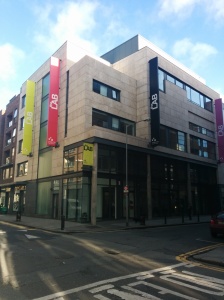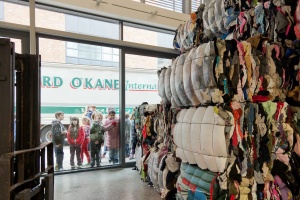Over the course of nine days in May, the Dublin Writers Festival captured the attention of the city, treating it to tales of trials and tribulations, weaving wonderful worlds for its people to explore – and seizing the chance to show us that the art of writing is very much alive and well.
This year, I was lucky enough to be a part of it. I took in four events throughout the festival, all of which covered vastly different topics; all of which helped me to realise that there’s a whole world of writers/weirdos out there that are just like me.
I was wooed to a “Date With An Agent”, taught a lesson in the school of crime-writing, enlightened into the story of the infamous whistleblower, Edward Snowden – and given a deep insight into the mind of a once-troubled comedian in Johnny Vegas.
Pretty varied, right?
Here’s a review of what I saw, witnessed and experienced, broken up into nice, sweet bunches of literary liquorish for you to enjoy… or, at least, to distract you until something more interesting comes along.
Day 1: Date With An Agent
Dating has never really been my strong point, so when I learned that I was to be a part of “Date With An Agent”, I began to worry about all those silly little things one associates with dating: what to wear, what to bring and, of course, what to talk about.
What to talk about? The answer should have been obvious: my book. It was the reason I was invited to attend after all. But there I was, fretting about which elements were the most important, which parts needed work – and what would make the agent I was meeting sit up and go: “I need to sell this”.
The event, hosted by The Inkwell Group’s Vanessa O’Loughlin, took place in Dublin Castle. Throughout the day, we were treated to writing workshops, given tasks and, not unexpectedly as prospective authors, told how to deal with the inevitable rejections coming our way. (In fact, the first hand-out we were given was emblazoned with the words, “COPING WITH REJECTION”, which raised more than a few uncomfortable laughs in the crowd.)
However, the focus of the day was, of course, the agents. We 75 would-be writers were here to pitch to them our books, our ideas and, in some cases, our very souls. They were here to listen to us, to critique us and, in some cases, take our ideas that little bit closer to reality.
Although I wouldn’t call my own “date” a resounding success, I definitely took some invaluable information from it. Being told that I wrote well was encouraging; being informed that my main character was a bit passive was, unfortunately, a truth I hadn’t really confronted before.
Overall, the event was worth attending. I met blossoming writers of all ages, all of whom wanted to tell their story; none of whom were so insular as to fail to ask me questions about my own book.
Whether phony or not, it was gratifying to hear their positive opinions on my story. I realised that we were all in the same boat: full of passion and hope, mixed in with a healthy dose of pragmatism.
The future of Irish novel-writing was sitting in that room with me and, I promise you, we have a lot to look forward to over the coming years.
Day 3: The State of Crime (with Arne Dahl, Brian McGilloway and Sinead Crowley)
One day you’re sitting in a room with 74 people just like you; two days later, you’re sitting listening to the musings of three of the most respected crime writers in Ireland and Europe.
I was live-tweeting this event on behalf of the Dublin Writers Festival – and, such were the fantastic insights given by the writers, boy were my fingers sore at the end!
Dahl, McGilloway and Crowley discussed their own books, the difference between crime-writing and other types of writing – and took questions from the crowd (like why so many crime writers feel the necessity to cram an irrelevant love story into an already packed novel!)
The event, despite the seriousness of the subject matter contained within crime novels, was light-hearted and jovial, with McGilloway in particular impressing, with his insights into how one writes a crime novel: “As a writer, you do the same as a detective: you work backwards.”
Dahl, more considered and thoughtful in his approach, tended to elongate his answers to questions, but endearingly so. In fact, some of the most profound points of the discussion came from his mouth: “It is a necessary pre-condition in crime novels to have a good plot, but it is not enough.”
Crowley, the only female member of the panel, was also an engaging presence, succinctly summing up how most writers feel from the beginning of a novel to the end: “Something I learned when writing my first book was how much things change as you’re writing.”
I’m not much of a crime reader, but after seeing such an esteemed group of bestselling writers in person, I can’t help but feel that I’m missing a trick by not taking advantage of what appears to be some of the most compelling contemporary writing out there.
Day 8: The Snowden Files (with Luke Harding)
After a work-enforced break from festival proceedings (damn you, financial commitments!), I returned to action, live-tweeting again, this time from the Smock Alley Theatre. This was, by far and away, my favourite event of the week.
Luke Harding, journalist with The Guardian and writer of “The Snowden Files”, captivated the large audience; not only with the description of his book, but also by providing insights into one of most intriguing people in the world, Edward Snowden.
For those who don’t know anything about Snowden (how was that rock you were living under?),he is, essentially, the person who exposed the NSA for the sneaky, underhanded, corrupt, shady organisation we and Hollywood think they are.
Over a number of months, Snowden, who had worked at the NSA, leaked important documents to journalists, all of which detailed that ‘Mericaw was not only spying on potential terrorists, but also its own people.
In this absorbing discussion, Harding, an eloquent speaker and all-round nice fellow, described Snowden’s journey from high school dropout to one of the most wanted men in the world.
What was most interesting was discovering that, although Snowden’s acts were bound to attract headlines, he was not like Julian Assange, the world’s most prominent “platinum-haired” whistleblower, in that he did not want to be famous; fame was thrust upon him.
I think it’s fair to say that those in the audience would have stayed listening to Harding talk for hours more – and his book, “The Snowden Files” is sure to be one of the most sought-after texts when history eventually examines these monumental events.
Day 9: Johnny Vegas in Conversation
The headline is misleading. This show was not about seeing Johnny Vegas in person. No, it was, in the end, about something much more profound, much more absorbing – and much more real.
On the last night of the festival, with live-tweeting privileges bestowed upon another, I was able to focus on what turned out to be one of the strangest events I have ever been at.
Johnny Vegas did not show up, primarily because Johnny Vegas is not real. He is the alter-ego of Michael Pennington, a very funny, very warm man, who created Vegas to confront his own fears and I haven’t read Pennington’s book yet (“Being Johnny Vegas”), so I hope I am not horribly wrong when I suggest that Pennington’s creation came about as a result of serious inflictions on his childhood. Although Pennington never used the term, “clerical abuse”, nor the word, “schizophrenia”, they are topics at which he heavily hints in his efforts to explain the story behind Vegas’s existence.
Interviewed by the (frankly, annoying) Pauline McLynn, Pennington proceeded to explain how Vegas became a part of him when he was at his most fragile. It is not Pennington we see on stage, but Vegas, a much more confident and indomitable personality than he.
Although the event was marred by some disruptive interviewing by McLynn – and the double sleeping couples on either side of me – it achieved its purpose. What I thought was going to be a run-of-the-mill comedy session was actually a much more insightful look into the psyche of a person whose worst experiences brought about the arrival of someone who gave joy to so many people. I now want to read Pennington’s book, something I would never have thought before I arrived at the National Concert Hall that night.
Summary:
Nothing worth having is easy, which is why the Dublin Writers Festival must be commended. To co-ordinate such an array of writing talent all around the city, all within the space of nine days, could not have been a simple task. I was not involved in it as much as I would have liked, but what I saw, I loved.
The fate of Irish writing lies within the people I came across during the week – and I know that we have nothing to fear in the future. We have Yeats and Wilde in us, but festivals like this instil within me the belief that there will be more Irish names on the tips of the tongues of future generations.
Watch this space – and come back for more next year.
By David Rafferty

















